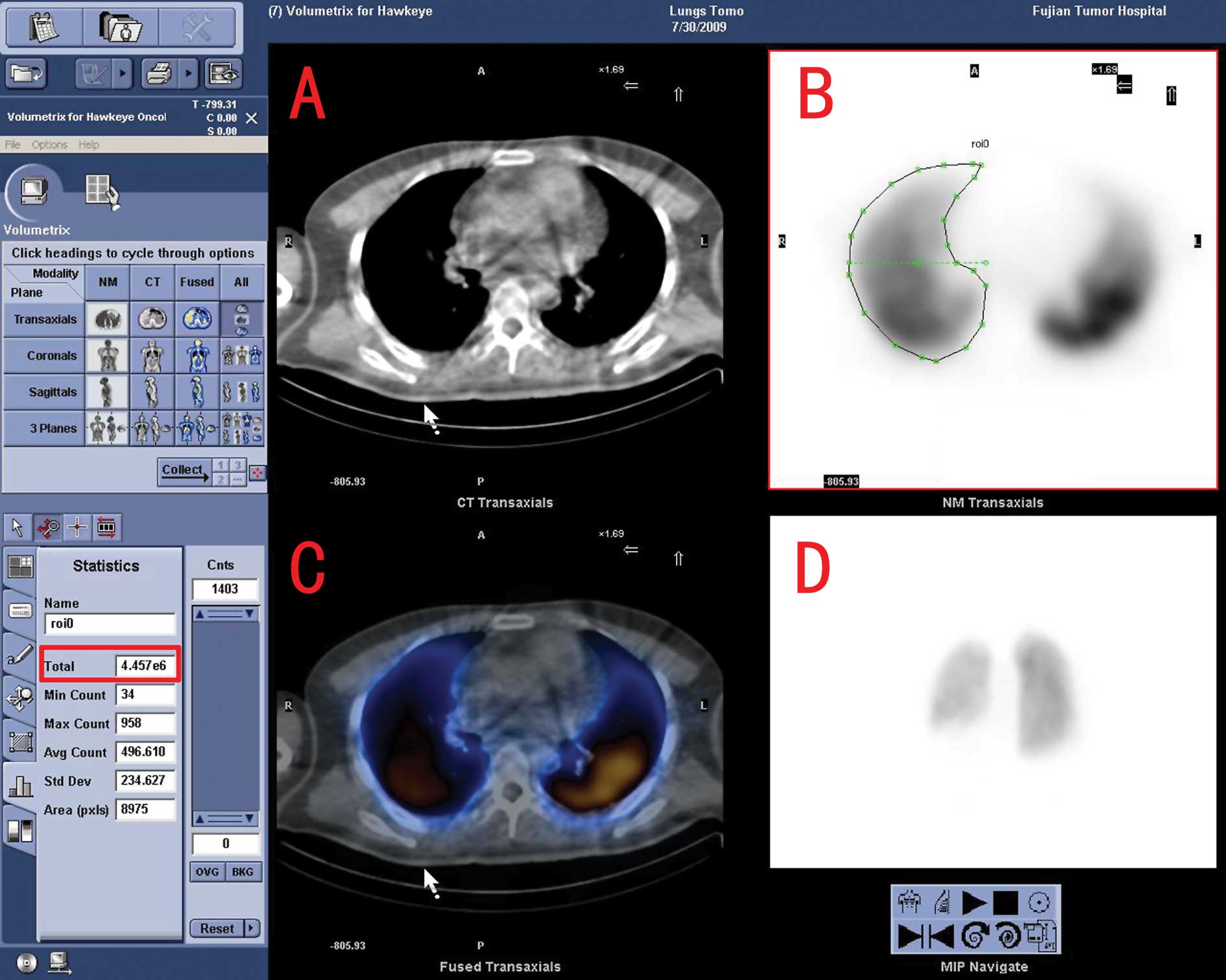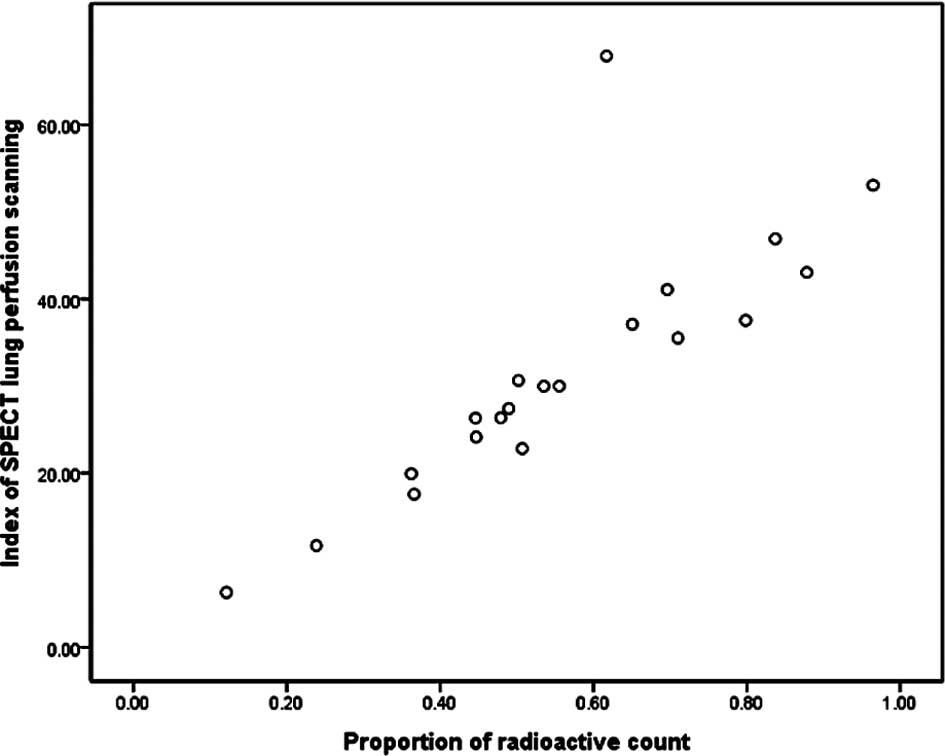|
1.
|
Mehta V: Radiation pneumonitis and
pulmonary fibrosis in non-small-cell lung cancer: pulmonary
function, prediction, and prevention. Int J Radiat Oncol Biol Phys.
63:5–24. 2005. View Article : Google Scholar : PubMed/NCBI
|
|
2.
|
Marks LB, Yu X, Vujaskovic Z, et al:
Radiation-induced lung injury. Semin Radiat Oncol. 13:333–345.
2003. View Article : Google Scholar : PubMed/NCBI
|
|
3.
|
Murshed H, Liu HH, Liao Z, et al: Dose and
volume reduction for normal lung using intensity-modulated
radiotherapy for advanced-stage non-small-cell lung cancer. Int J
Radiat Oncol Biol Phys. 58:1258–1267. 2004.PubMed/NCBI
|
|
4.
|
Sura S, Gupta V, Yorke E, et al:
Intensity-modulated radiation therapy (IMRT) for inoperable
non-small cell lung cancer: the Memorial Sloan-Kettering Cancer
Center (MSKCC) experience. Radiother Oncol. 87:17–23. 2008.
View Article : Google Scholar : PubMed/NCBI
|
|
5.
|
Yom SS, Liao Z, Liu HH, et al: Initial
evaluation of treatment-related pneumonitis in advanced-stage
non-small-cell lung cancer patients treated with concurrent
chemotherapy and intensity-modulated radiotherapy. Int J Radiat
Oncol Biol Phys. 68:94–102. 2007. View Article : Google Scholar
|
|
6.
|
Graves PR, Siddiqui F, Anscher MS, et al:
Radiation pulmonary toxicity: from mechanisms to management. Semin
Radiat Oncol. 20:201–207. 2010. View Article : Google Scholar : PubMed/NCBI
|
|
7.
|
Ghafoori P, Marks LB, Vujaskovic Z, et al:
Radiation-induced lung injury. Assessment, management, and
prevention. Oncology (Williston Park). 22:37–47. 2008.PubMed/NCBI
|
|
8.
|
Spyropoulou D, Leotsinidis M, Tsiamita M,
et al: Pulmonary function testing in women with breast cancer
treated with radiotherapy and chemotherapy. In Vivo. 23:867–872.
2009.PubMed/NCBI
|
|
9.
|
Allen AM, Henning GT, Ten Haken RK, et al:
Do dose-volume metrics predict pulmonary function changes in lung
irradiation? Int J Radiat Oncol Biol Phys. 55:921–929.
2003.PubMed/NCBI
|
|
10.
|
De Jaeger K, Seppenwoolde Y, Boersma LJ,
et al: Pulmonary function following high-dose radiotherapy of
non-small-cell lung cancer. Int J Radiat Oncol Biol Phys.
55:1331–1340. 2003.PubMed/NCBI
|
|
11.
|
Miller KL, Zhou SM, Barrier RC Jr, et al:
Long-term changes in pulmonary function tests after definitive
radiotherapy for lung cancer. Int J Radiat Oncol Biol Phys.
56:611–615. 2003. View Article : Google Scholar : PubMed/NCBI
|
|
12.
|
Theuws JC, Kwa SL, Wagenaar AC, et al:
Dose-effect relations for early local pulmonary injury after
irradiation for malignant lymphoma and breast cancer. Radiother
Oncol. 48:33–43. 1998. View Article : Google Scholar : PubMed/NCBI
|
|
13.
|
Kim S, Kim HK, Kang DY, et al:
Intra-operative sentinel lymph node identification using a novel
receptor-binding agent (technetium-99m neomannosyl human serum
albumin, 99mTc-MSA) in stage I non-small cell lung cancer. Eur J
Cardiothorac Surg. 37:1450–1456. 2010. View Article : Google Scholar
|
|
14.
|
Zhang WJ, Zheng R, Zhao LJ, et al: Utility
of SPECT lung perfusion scans in assessing early changes in
pulmonary function of patients with lung cancer after radiotherapy.
Ai Zheng. 23:1180–1184. 2004.PubMed/NCBI
|
|
15.
|
Ahn BC, Kim HJ, Lee SW, et al: New
quantitative method for bone tracer uptake of temporomandibular
joint using Tc-99m MDP skull SPECT. Ann Nucl Med. 23:651–656. 2009.
View Article : Google Scholar : PubMed/NCBI
|
|
16.
|
Munley MT, Marks LB, Hardenbergh PH, et
al: Functional imaging of normal tissues with nuclear medicine:
applications in radiotherapy. Semin Radiat Oncol. 11:28–36. 2001.
View Article : Google Scholar : PubMed/NCBI
|
|
17.
|
Curran WJ Jr, Moldofsky PJ and Solin LJ:
Observations on the predictive value of perfusion lung scans on
post-irradiation pulmonary function among 210 patients with
bronchogenic carcinoma. Int J Radiat Oncol Biol Phys. 24:31–36.
1992. View Article : Google Scholar
|
|
18.
|
Boersma LJ, Damen EM, de Boer RW, et al:
Estimation of overall pulmonary function after irradiation using
dose-effect relations for local functional injury. Radiother Oncol.
36:15–23. 1995. View Article : Google Scholar
|
|
19.
|
Miller KL, Shafman TD, Anscher MS, et al:
Bronchial stenosis: an underreported complication of high-dose
external beam radiotherapy for lung cancer. Int J Radiat Oncol Biol
Phys. 61:64–69. 2005. View Article : Google Scholar : PubMed/NCBI
|
|
20.
|
Marks LB, Munley MT, Spencer DP, et al:
Quantification of radiation-induced regional lung injury with
perfusion imaging. Int J Radiat Oncol Biol Phys. 38:399–409. 1997.
View Article : Google Scholar : PubMed/NCBI
|
|
21.
|
Zhang J, Ma J, Zhou S, et al:
Radiation-induced reductions in regional lung perfusion: 0.1-12
year data from a prospective clinical study. Int J Radiat Oncol
Biol Phys. 76:425–432. 2010.PubMed/NCBI
|
|
22.
|
Kong FM, Frey KA, Quint LE, et al: A pilot
study of [18F]fluorodeoxyglucose positron emission tomography scans
during and after radiation-based therapy in patients with non
small-cell lung cancer. J Clin Oncol. 25:3116–3123. 2007.
|
|
23.
|
Theuws JC, Seppenwoolde Y, Kwa SL, et al:
Changes in local pulmonary injury up to 48 months after irradiation
for lymphoma and breast cancer. Int J Radiat Oncol Biol Phys.
47:1201–1208. 2000. View Article : Google Scholar : PubMed/NCBI
|
|
24.
|
Woel RT, Munley MT, Hollis D, et al: The
time course of radiation therapy-induced reductions in regional
perfusion: a prospective study with >5 years of follow-up. Int J
Radiat Oncol Biol Phys. 52:58–67. 2002.PubMed/NCBI
|
|
25.
|
Marks LB, Hollis D, Munley M, et al: The
role of lung perfusion imaging in predicting the direction of
radiation-induced changes in pulmonary function tests. Cancer.
88:2135–2141. 2000. View Article : Google Scholar : PubMed/NCBI
|
|
26.
|
Fan M, Marks LB, Lind P, et al: Relating
radiation-induced regional lung injury to changes in pulmonary
function tests. Int J Radiat Oncol Biol Phys. 51:311–317. 2001.
View Article : Google Scholar : PubMed/NCBI
|
















